The River-side welcomes this guest post from Kate O’Brien and Donncdha Carroll, students on the 2016/2017 MA in Medieval History in UCC, that includes the HI6091: Skills in Medieval History module. HI6091 is taught by Dr Malgorzata Krasnodębska-D’Aughton, recently selected for a President’s Award for Excellence in Teaching 2016/2017 and Elaine Harrington. The module featured in the Award application as an illustration of the teaching approach that combines traditional skills of a historian with a creative use of technology. Part of the HI6091 module, Dr D’Aughton designed, includes a specifically tailored work placement that focuses on public outputs. Donncdha Carroll and Kate O’Brien spent six weeks in Special Collections providing collection care on St Fin Barre’s Cathedral Library Collection and creating a finding aid for an uncatalogued collection of Photostats. Kate and Donncdha had previously written posts for The River-side as part of The Book of Kells student exhibition hosted on The River-side.
Introduction
Earlier this year UCC Library’s website updated its look making its easier to navigate. As part of that update the Special Collections’ team worked to make available more information about the collections including the finding aids required to access newspapers, microform and manuscripts on microform. Stay tuned to the Special Collections Guides for these as they’re released over the next few months! I asked Kate and Donncdha to write about their favourite book from St Fin Barre’s Cathedral Library Collection that they worked on and secondly to explain what Photostats were and how they could be used.
About St Fin Barre’s Cathedral Library
St Fin Barre’s Cathedral Collection was founded in 1720 by Bishop Peter Browne (1665-1735) and it was purchased by the University College Cork Library in 1984. The private collections of Archdeacon Pomeroy (1725), Bishop Crow of Cloyne (1727) and Bishop Stopford (1805) form the bulk of the collection which consists of c3,000 volumes. The main subject areas are theology and ecclesiastical matters, but the classics, history, literature and science are also represented. Most of the books were printed in the 16th, 17th and 18th centuries, chiefly in London and Dublin. There are three small collections of pamphlets dealing with: (i) the Popish plot, and religious controversy, etc of the last quarter of the 17th century, chiefly English printing; (ii) Political and miscellaneous tracts of the early 18th century, chiefly Dublin printing; (iii) Irish pamphlets of the last decades of the 18th century, tithe war, economics, politics etc. Languages present in the collection include:French, German, Italian, Latin, Irish Gaelic, Greek, Dutch and Spanish. For more information on the collection see:
- Caulfield, Richard. “Description of the Library of St Fin Barre’s Cathedral, Cork.” Journal of the Cork Historical & Archaeological Society 11 (1905): 96-98.
- Tallon, Maura. “Church of Ireland Diocesan Libraries.” An Leabharlann 17 (1959): 22-23.
St Fin Barre’s Cathedral Library Collection: Kate’s Favourite Book
My favourite book that I came across in this collection was the sixth and last volume in the set of A Collection of Theological Tracts in Six Volumes by Richard Watson (A.4.27d v.6). The book was published in 1785 (M.DCC.LXXXV). Richard Watson (1737-1816) was an Anglican Bishop of Llandaff and a theologian from Cumbria. He was a key member in the Revolution Controversy which was the late 18th century British debate regarding the French Revolution.
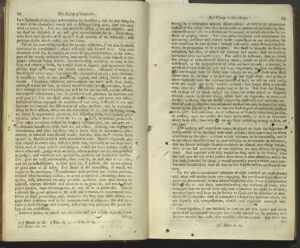
One of the reasons why this book is so interesting are the marks in it. Fragments of bullets have been found embedded in this copy of the book, along with the holes and other damage caused by the impact of shooting. Although not much is known about how this volume came to be in such a condition, it is certainly a unique example of a book that witnessed some turbulent event. What first alerted us to the unusual marks within the book was a small paper bookmark, which simply had the word ‘shot’ written on it and was sticking out from between the leaves. After doing research on the history of the volume and collection, I couldn’t find any further information that would give us a clue to help solve the mystery that this book presents.
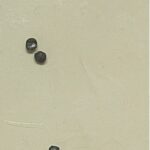
St Fin Barre’s Cathedral Library Collection: Donncdha’s Favourite Book
The book I have chosen as my favourite from S. Fin Barre’s Cathedral Collection is Reginald Scot’s 1584 treatise The Discouerie of Witchcraft. The text deals with alleged instances of witchcraft and magic, which the author questions and explains as scientific phenomena or tricks that are used to make people believe in the dark arts. Scot is decidedly dismissive of the idea of magic, viewing belief in magic as unchristian. There are a number of reasons why this book sparked my interest.
Firstly why would this text be in the Cathedral’s collection? A preliminary examination suggests that the book is out of place among religious texts and treatises on the Scripture. However, further examination reveals that the book was part of the collection due to the fact that it dismisses magic and witchcraft and explains why the author does not believe they exist. The treatise’s Christian stance fits well with the general character of the collection. The book is also interesting as a text seen in its contemporary context. At the time, magic was not regarded as a superstition of the past. One of the leading advocates and writers on the dangers of witchcraft was King James VI.
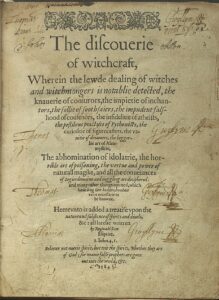
Secondly, what I found interesting on a more human level is the presence of many signatures on the title page of this particular copy of the text. The signature of a certain Thomas is repeated a number of times along with another signature that seems to spell out ‘Gwyllym.’ The name ‘John’ is signed. These names add a personal dimension to the history of the volume. I attempted to find out who the signatures belonged to in order to track the history of the book. The volume could have belonged to a Welsh family that moved to Herefordshire where we find a Thomas Gwyllym in 1722 and another Thomas Gwyllym who died in 1742. While it is uncertain if the two names are the same person they most definitely the same family.
For more about The Discouerie of Witchcraft see Dr. Edel Semple’s blog post about Shakespeare’s historical sources. Dr Semple is based in the School of English, UCC and her post was based on a lecture she gave as part of Culture Night 2016.
About Photostats
The term ‘Photostat’ was a trade name and generic title for photographing documentation directly on to sensitised paper which produced a clear and easily readable image. Using photostats as a method of documenting historical material such as manuscripts was first pioneered by Lodewyk Bendikson (1875-1953). When a Photostat image is first taken it is produced as a negative (white on black). It is then photographed again to produce a positive (black on white) copy of the graphic material which uses sensitised paper and prints as a readable text image rather than reversed. The image captures the manuscript’s folio in high quality making it easily legible and as such a useful tool of research when the original manuscript is not available. In comparison to microfilm photostats can be used anywhere and do not require the same level of equipment. In cases where microfilm is not suitable and the original text is not available, photostats act as an excellent research tool. An example of an undated photostat is [Proclamation against Archbishop Rinuccini].
Kate’s Favourite Photostat – RIA 23 E 29
One of the most interesting Photostats that I found during the cataloguing process was a Photostat of the Royal Irish Academy manuscript Ms 23 E 29 also known as The Book of Fermoy. The manuscript was made between the 14th and 16th centuries in Castletownroche, outside Fermoy, Co. Cork. According to the Royal Irish Academy online catalogue, it was made by several scribes including Domhnall Ó Leighin, Uilliam Ó hIcedha, Dáibith Ó Duib and Torna Uí Mhaoil Chonaire. It contains material relating to the Roche family, lives of saints, medical treatises, mythological tales, genealogies, historical tracts, a fragment of Lebor Gabala (The Book of Invasions) and poetry.
A note within the Photostat claims that the manuscript contains the earliest surviving manuscripts of Finbarr’s vernacular Life, a statement which upon further research I could corroborate. This note also informs us that the manuscript was copied by Domhnall O’Leighin between 1450 and 1460, for David, the son of Maurice Roche, who was the head of the Roche lordship in north-east Cork. Unfortunately, due to the loss of a folio in the manuscript, the copy of the Life is only fragmentary.
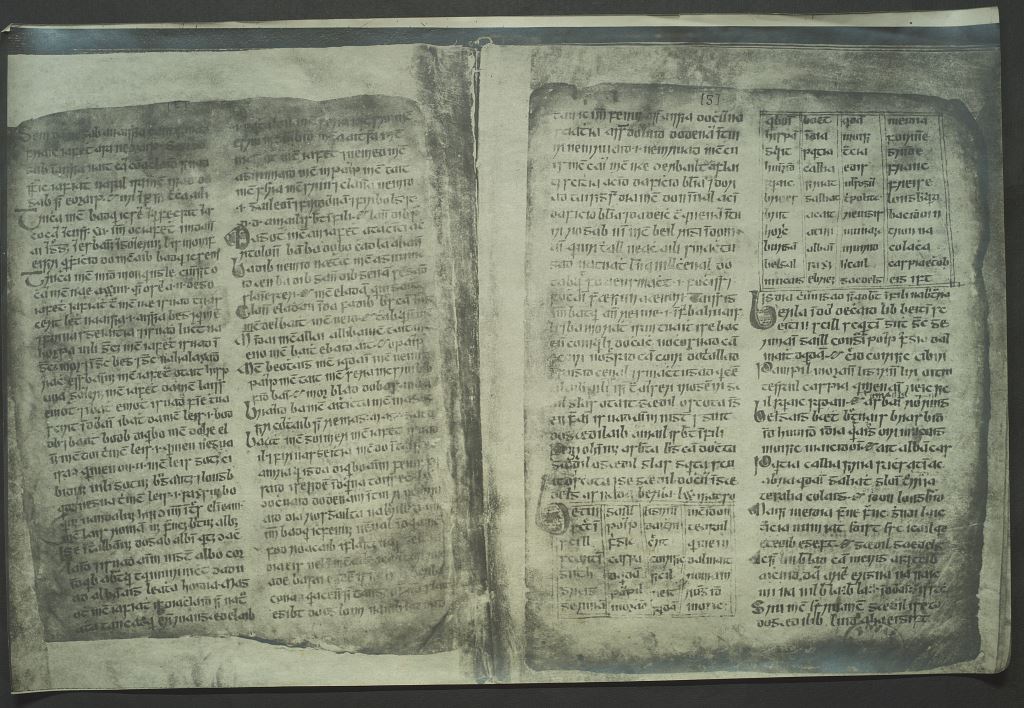
This Photostat, like many others that I have listed during the MA work placement, presents the text written in Irish and in cursive handwriting, making it hard to read. Yet, a good amount of information both printed and online about the RIA manuscript, makes it easier to examine and follow the text on the Photostat. There are a few pieces of decoration throughout the text, mostly embellishments of capital letters. Some spaces have been left for later decoration that was unfortunately never completed. Once can tell from the positive Photostat, that the manuscript wasn’t in good condition when the Photostat was created. Since the Photostat was made, the original manuscript has undergone restoration in 1975, when Roger Powell re-bound, flattened and repaired the leaves, before it was resewn.
This was my favourite Photostat as it touched a wide range of topics. Although the text on the Photostat and the original manuscript were hard to read, a wealth of published and electronic information on the manuscript available helped me follow the manuscript’s contents. The section with mythological tales was one of my favourite sections of this Photostat.
Donncdha’s Favourite Photostat – Survey and Catalogue of the Walls of Cork
In the process of listing the Photostats I found my favourite example: a copy of a Survey and Catalogue of the Walls of Cork City. This Photostat covers a number of pages, each one tracking the condition of the city fortifications during the 18th century. This Photostat opened interesting avenues of research such as investigating the reason behind the survey and the identity and position of the overseer of the survey named Jehosephat Huleatt – as spelled on the Photostat.
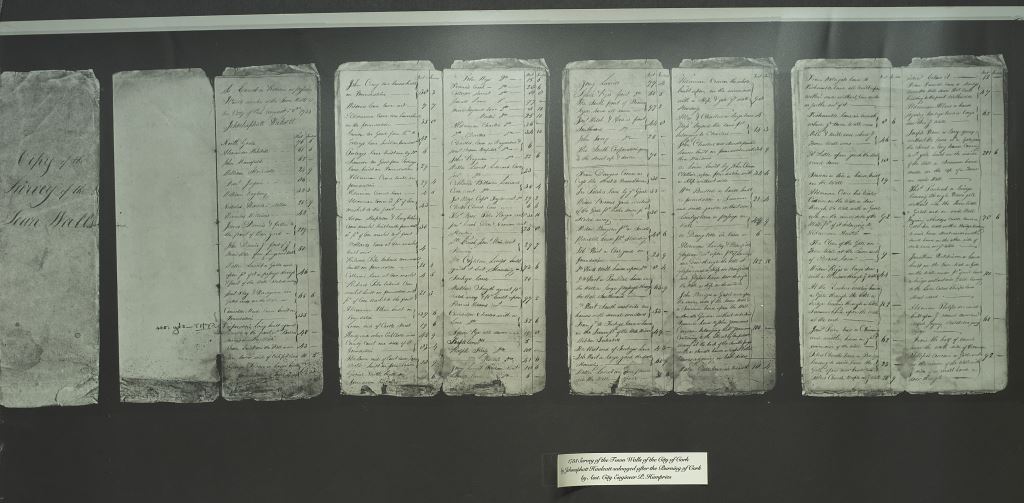
Mr Huleatt is recorded in the Council Book of the Corporation of the City of Cork to have been an overseer of public works for the town of Cork in 1745. This Photostat seems to be an image of a particular survey of the condition of the walls he was commissioned to do. It is interesting that his name is mentioned both on the Photostat and in the city records, however there are six variations in how it is spelled. Mr Huleatt was replaced as an overseer on the 2 February 1757 by a Mr Taylor and does not appear in the records again.
Jehosephat Huleatt was involved with a number of different projects aiming to renovate and expand the walls of Cork, as found in the records:
“Whereas some persons have broken part of the Town Walls eastward of the South Gaol, and therein fixed a door and door-case, ordered, that said door, be removed, and the breach stopped with stones and mortar, and that Jehosaphat Huleatt oversee said work.” [Council Book of the Corporation of the City of Cork 698]
This Photostat offers a detailed account of a town survey that is useful for understanding administration and development of 18th-century Cork. It also offers an insight into the life and work of a specific individual.
Comments are closed.
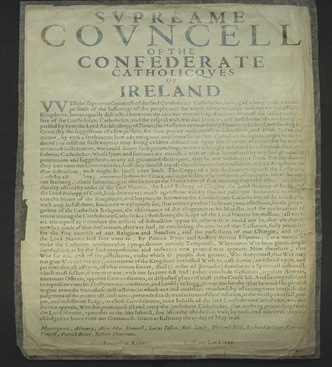





[…] History students in the past two years have availed of an exciting and rare opportunity of being on work placements in Special Collections. They have created online exhibitions inspired by rare books housed by Special Collections as part […]
[…] students in the past three years have availed of an exciting and rare opportunity of being on work placements in Special Collections. They have created online exhibitions inspired by rare books and facsimiles housed by Special […]